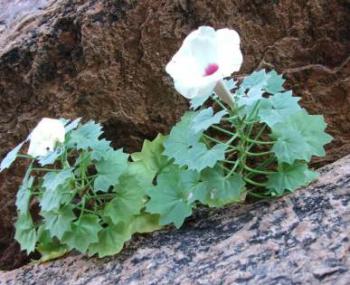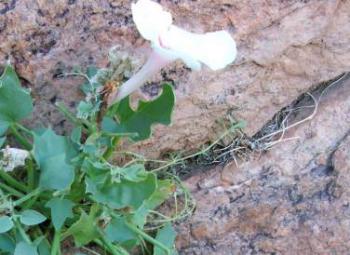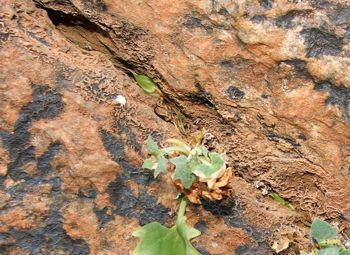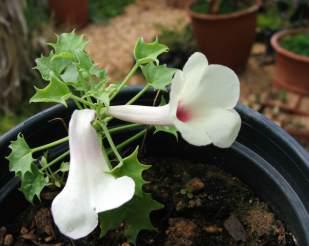Dewinteria petrophila
Dewinteria petrophila (De Winter) Van Jaarsv. & E.E. van Wyk
Family: Pedaliaceae
Common names: Kaokoveld klipblom (Afr.)
Introduction
Dewinteria petrophila is remarkable for its amazing reproduction on cliff faces. Apart from producing normal leaves, fruits and wind-dispersed seed, it also produces soft, thread-like trailing branches from the base of its stems which enter rock crevices and bear small, self-fertilized flowers, heart-shaped capsules and fewer, but larger seeds.

Description
Description
Dewinteria petrophila is a soft, squat to trailing perennial herb with its main branch up to 200 x 3-4 mm, drooping from cliff faces. Most parts of the plant have mucilage glands. The base of the stem is slightly swollen (somewhat ovate and up to 5 mm in diameter) and compressed in rock crevices. The roots are fibrous. Small, thread-like, trailing branchlets (up to 200 mm long) grow from the base of the main branch, away from the light source, entering crevices.
When stems grow away from the light source it is termed phototropic negative. Grey-green leaves on the main branch, with petioles 20-60 mm long, are semi-succulent, opposite (internodes 8-14 mm), up to 40 x 55 mm and broadly heart- to kidney-shaped with coarse teeth on the margins. At the base of the leaf stalks (petioles) the plant has nectar glands known as extrafloral nectaries.
The small, thread-like branches at the base of the main branch also bear leaves which are small, entire and egg-shaped (ovate), 2-4 x 0.6-1.7 mm, with petioles 3-4 mm long. These branches produce small, self-fertilized flowers (2 mm long), smaller, flattened heart-shaped capsules, 5-8 x 4.0-5.5 mm and produce fewer but larger seeds, 2.5-3.0 mm long. These filiform branches are annual and usually die back after fruiting.

The normal flowers on the aerial stems of Dewinteria petrophila are produced in the axils (base of leaf stalk), are conspicuous, trumpet-shaped, 30-70 mm long, cream-coloured to pale yellow and purplish in the throat and tube. The flower stalk (pedicel) is about 1.2-4.0 mm long. The calyx is 5-lobed, elongated triangular and up to 3 mm long. The flower (corolla) ends in 5 broadly egg-shaped lobes, the lower pair slightly larger, and is slightly swollen at the base and sparsely covered with mucilage glands. The 4 stamens are up to 12 mm long. The capsules are 18-25 mm long, lance-shaped, tapering into a curved point, and flattened. Capsules contain many brown, rod-like, up to 2 mm long seeds.
Conservation Status
Status
Dewinteria is endemic to the Kaokoveld Centre of Endemism, an arid region in northwestern Namibia and adjacent southwestern Angola. It is locally abundant and well protected by its cliff face habitat.
Distribution and habitat
Distribution description
Dewinteria petrophila grows in crevices of granite rock on all aspects, from an altitude of about 800-1700 m. However, it is more prominent on southern aspects which are cooler and retain moisture for longer periods. It is commonly found on the Otjihipa Mountain and adjacent mountain ranges.

The Otjihipa Mountain is a twin-peaked granite massif, and is situated just east of Otjihungwa, its highest point 1915 m. The vegetation consists mainly of mopane veld (Colophospermum mopane) with Commiphora well represented. Rainfall is mainly in summer, the lower slopes receive about 50-75 mm per annum but at least 200 per annum on its upper slopes. The mountain lies within the tropics and the climate is very hot during summer and less so in winter. The upper slopes receive fog and are cooler, with elements of Cape vegetation such as Eriocephalus, Othonna and Pelargonium species. The crevices that Dewinteria occupies may sometimes be very small and hairline (De Winter 1961) but the plant also grows in larger cracks. The subterranean fruiting capsules produced on the thread-like basal branches deep within the crevices are often well wedged and impossible to remove from deep fissures. Dewinteria petrophila shares its habitat with succulent plants such as Tetradenia kaokoensis, Aeollanthus, Kalanchoe lanceolata and Plectranthus dinteri.
Related species
Although previously contained in the Rogeria genus, Dewinteria petrophila is not closely related to any other southern African Rogeria species (Smithies & Herman 2004). It occurs together with Rogeria bigibbosa and R. adenophylla, which are sturdy, erect annuals from dry streambeds adjacent to the cliffs where D. petrophila occurs. However, their habitats are never shared. Other Rogeria species also bear long, tubular flowers but with very woody armoured capsules and different flattened seeds. Rogeria longiflora is another species from this region and occurs further south in the lower Orange River Valley. It is very possible that D. petrophila occurs in Angola, the adjacent mountains north of the Kunene River which are of similar geological origin.
Derivation of name and historical aspects
History
This plant was previously known as Rogeria petrophila but its taxonomic status has been re-evaluated owing to its unique morphology. Dewinteria petrophila differs from Rogeria species on the basis of its "fruiting capsules, texture and morphology of the seeds and specialized filiform basal branches" (Van Jaarsveld & Van Wyk 2007).
Dewinteria petrophila was first collected by Dr Bernard de Winter (former director of the Botanical Research Institute) and Dr Otto Leistner, (botanist and editor at the Botanical Research Institute), in an expedition to the Kaokoveld in 1957 (Gunn & Codd 1981).
The new genus name Dewinteria was named in honour of Dr Bernard de Winter, retired Director of the former Botanical Research Institute in Pretoria.
There are six Rogeria species, four of which are endemic to the semi-arid and arid western parts of South Africa and Namibia, one in northern Africa and another in Brazil. Dewinteria belongs to Pedaliaceae, a small family of about 70 species (mostly African) which are generally classified according to fruit type. Plants within this family vary considerably and include annuals, biennials, perennials, chamaephytes and dwarf trees.
Ecology
Ecology
The Kaoko klipblom flowers mainly during summer and autumn but sporadically at other times of the year, is pollinated by insects, and the seeds are wind dispersed. The plant grows in granite fissures, mostly out or reach on cliffs and boulders. The stem base is slightly swollen, and well wedged in the crevices.

It has remarkable dual seed production and dispersal strategies, which act as a back-up or insurance policy ensuring its long-term survival. Aside from wind-dispersed normal seed, plants develop thread-like branches which also produce seeds to bury deep in the dark crevices (autochory). Should the mother plant die, the larger seeds of its cloned offspring, already buried deep within the crevice, should germinate and grow into normal plants, replacing the mother plant and thus continuing growth when conditions improve.
The only difference between the two fruit types are that the normal seeds are produced following cross pollination from adjacent populations (out-crossing), whereas the crevice capsule's seeds are the result of self pollination, thus identical to the parent plant genes.
How does this plant bear capsules without flowers? The thread-like (filiform) branches were carefully examined to reveal tiny nectar glands in the leaf axils and these modified nectaries form small, self-fertilized (cleistogamous), inconspicuous flowers. The nectaries glands are typical of the Pedaliaceae family (normally produced at the base of the pedicles).
This is the first record in the world of this cliff-dwelling dispersal strategy. It is the long-term environmental pressure (aridity, disturbance) which led to this remarkable adaptation (survival strategy). Dewinteria petrophila is one of the most advanced of all cliff-adapted plant species. Additionally, the seeds are covered with mucilage which is thought to help with water uptake.
Parallel vegetative dispersal adaptation is prevalent amongst other cliff- and crevice-dwelling succulent and bulbous plants. Succulent and succulent bulbous plants are more prominent on cliff faces and many species are only found there. Their succulent nature enables them to cope with dry periods, and explains why so few herbaceous plants are found on cliffs. Other cliff dwellers also have a dispersal back-up system: Many bulbs form vegetative bulbils (Cyrtanthus montanus, Ornithogalum juncifolium var. emsii, Oxalis fergusoniae, O. pocockiae). Many of the members of the Crassulaceae such as Adromischus have brittle leaves which easily become detached and root where they land.
Uses
Use
No uses have been recorded for the plants.

Growing Dewinteria petrophila
Grow
Dewinteria petrophila is best propagated from seed. Sow during late spring in a sandy mixture and treat with a fungicide. If grown in a wet area outside of the tropics, it is best planted in a greenhouse under controlled conditions. Transplant the young plants to containers as soon as they are large enough to handle. The plant can be grown in full sun or light shade. It is best to water through capillary action and a mild, liquid fertilizer may be applied.
References
- De Winter, B. 1961. Rogeria petrophila. In J.G. Anderson et al., New and interesting taxa from southern Africa. Kirkia 1: 106-108.
- Gunn, M. & Codd, L.E. 1981. Botanical exploration of southern Africa. Balkema, Cape Town.
- Jackson, W.P.U. 1990. Origins and meaning of names of South African plant genera. University of Cape Town Ecolab, Rondebosch.
- Smithies, S.J. & Herman, P.P.J. 2003. Pedaliaceae. In G. Germishuizen & N.L. Meyer, Plants of southern Africa : an annotated checklist. Strelitzia 14: 772-774. National Botanical Institute, Pretoria.
- Van Wyk, B-E. & Wink, M. 2004. Medicinal plants of the World. Briza Publications, Pretoria.
- Van Jaarsveld, E.J. & Van Wyk, A.E. 2007. Pedaliaceae: Dewinteria, a new semisucculent, cliff-dwelling genus endemic to the kaokoveld, Namibia. Bothalia 37(2)
Credits
Ernst van Jaarsveld
Kirstenbosch National Botanical Garden
January 2007
Name updated July 2008
Plant Attributes:
Plant Type: Perennial
SA Distribution:
Soil type:
Flowering season: Early Summer, Late Summer
PH: Acid
Flower colour: White
Aspect: Full Sun, Morning Sun (Semi Shade)
Gardening skill: Challenging
Special Features:
Horticultural zones








Rate this article
Article well written and informative
Rate this plant
Is this an interesting plant?
Login to add your Comment
Back to topNot registered yet? Click here to register.